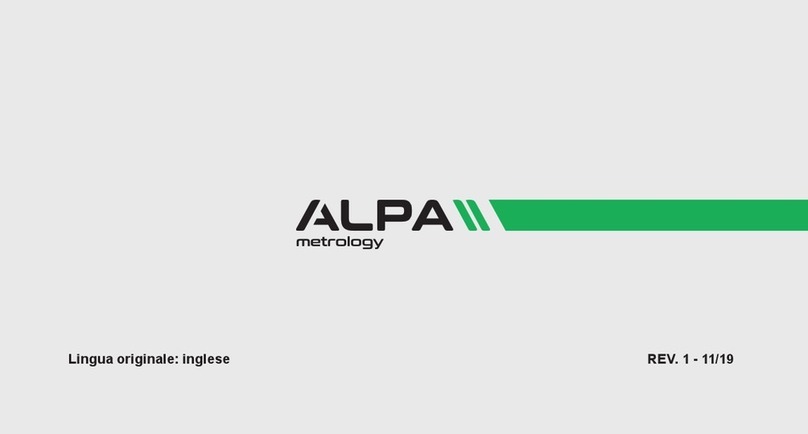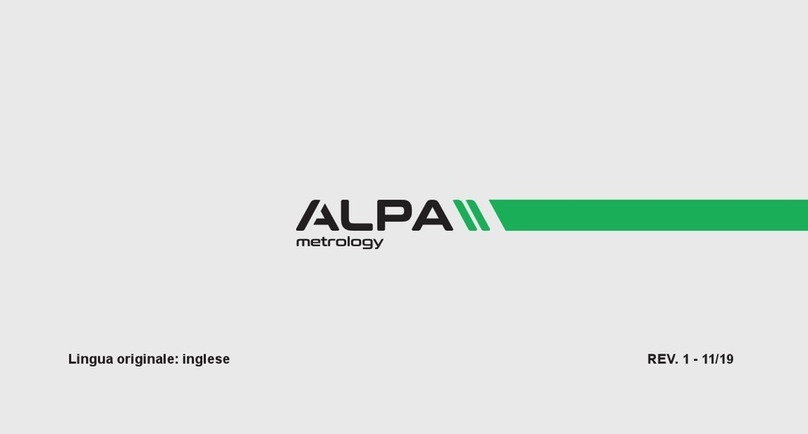
5
RU
PL
ES
DE
IT
EN
2.1 INSTRUMENT
1. Height Gauge
2. Screwfortheadjustmentoftheoatingprobesuspension
3. Handle for carriage displacement
4. Transport safety screw for locking of probe suspension (chromium plated)
5. Lower probe holder
6. Insert holder
7. Measuring insert
8. Operating handle for the displacement of the instrument
9. Base with air cushion system for instrument displacement
10. Button for activation of air cushion and programmable functions keys
11. Handwheel for measuring carriage displacement and probing movement
2.2 INTERFACES/CONNECTORS
12. Mini USB connector (on top of display unit)
13. Connector for RS232 communication (on lower right side of height gauge)
14. AC adaptor connection (on lower right side of height gauge)
2.3 DISPLAY
21. Number of current reference
22. Function indicator
23. Active measuring unit
24. Probe constant indicator
25. Min / Max / Delta mode indicator
26. Inversion of measuring direction indicator
27. Probe holder change indicator
28. Shrinkingfactor≠1indicator
29. Direct display mode indicator
30. Motorisation indicator
31. Battery charge level indicator
32. Probing indicator
33. “Diameter/centreline” mode – Value of diameter indicator
34. Height measurement and probing direction indicator
35. “Diameter/centreline” mode – Value of centreline indicator
36. Tolerance limit/difference mode indicator
37. Upper display line
38. Lower display line
39. Visual signal of function activation
2.4 KEYBOARD
40. Selection of references / numeric function 7
41. Selection of resolution / numeric function 8
42. Selection of measuring unit (mm/inch) / numeric function 4
43. Min,maxordeltamode/numericfunction5
44. Up arrow / numeric function 1
45. Down arrow / numeric function 2
46. Zero setting of the display / numeric function 0
47. On/Off key (power ON / OFF)
48. Storage of probe constant / numeric function 9
49. Print-out of data / Function “+/-”
50. Average of last 2 measurements / numeric function 6
51. Function key: Selection of height and diameter - centerline measurements
Validation key
52. Difference between last 2 measurements / numeric function 3
53. Sets the display to the previously input preset value of the current
reference Function “.”
2.1 STRUMENTO
1. Colonna di misura
2. Vite di bilanciamento tastatore
3. Manopola per lo spostamento del carrello
4. Vite di blocco del carrello (vite nichelata)
5. Porta tastatore
6. Braccio porta-tastatore
7. Tastatore
8. Manopola per lo spostamento dello strumento
9. Base con cuscino d’aria
10. Pulsante per l’attivazione del cuscino d’aria e pulsanti delle funzioni
programmabili
11. Manopola per lo spostamento manuale del carrello
2.2 CONNETTORI
12. Connettore Mini USB (posto sul retro dello schermo)
13. Connettore per la comunicazione RS232 (posto sull’altimetro)
14. Connettore di alimentazione (posto sull’altimetro)
2.3 SCHERMO
21. Visualizzazione del riferimento corrente
22. Indicatore di funzione
23. Unità di misura corrente
24. Indicatore di acquisizione della costante
25. Indicatore della modalità Min / Max / Delta
26. Indicatore d’inversione del senso di misura
27. Indicatore di cambio del porta tastatore
28. Indicatoredelfattorediritiro≠1
29. Indicatore della modalità di misura diretta
30. Indicatore della motorizzazione
31. Indicatore del livello di carica della batteria
32. Indicatore della presa del punto
33. Indicatore della modalità di misura “diametro/interasse” – valore del
diametro
34. Indicatore della modalità di misura “altezze”
35. Indicatore della modalità di misura “diametro/interasse” – valore
dell’interasse
36. Indicatore della modalità Differenza
37. Riga superiore dello schermo
38. Riga inferiore dello schermo
39. Segnale visivo di attivazione della funzione
2.4 TASTIERINO
40. Selezione del riferimento / Funzione numerica 7
41. Cambio di risoluzione / Funzione numerica 8
42. Selezione dell’unità (mm / inch) / Funzione numerica 4
43. Modalitàmin,maxodelta/Funzionenumerica5
44. Freccia verso l’alto / Funzione numerica 1
45. Freccia verso il basso / Funzione numerica 2
46. Azzeramento / Funzione numerica 0
47. Pulsante On/Off (accensione e spegnimento)
48. Misura della costante / Funzione numerica 9
49. Invio o stampa dei dati / Funzione “+/-”
50. Centro della cava / Funzione numerica 6
51. Tasto funzione: selezione delle modalità “altezze” e “diametro-interasse”
Tasto di conferma
52. Differenza tra le 2 ultime misure / Funzione numerica 3
53. Preset relativo al riferimento corrente / Funzione “.”












































